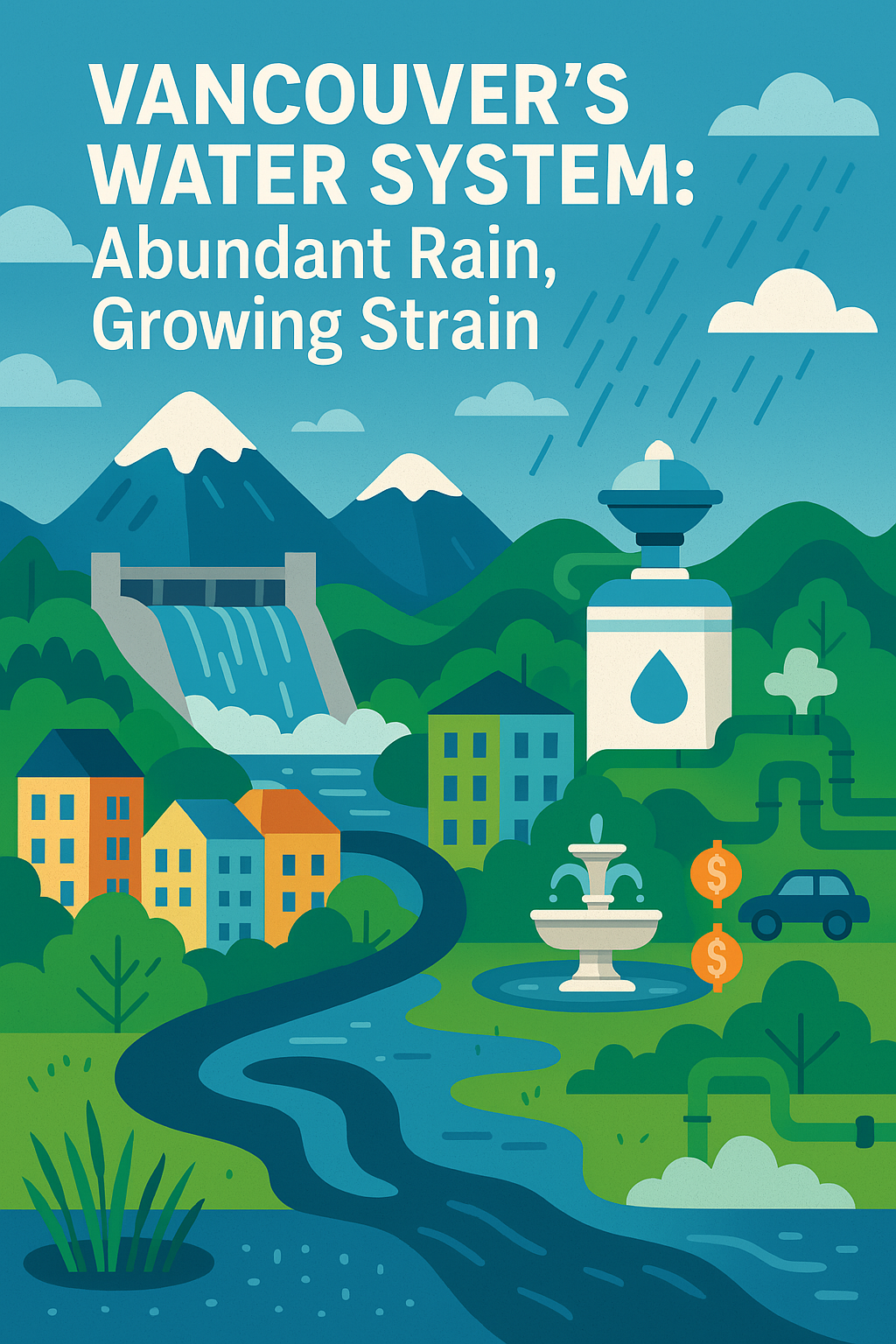
Vancouver, BC - April 4th, 2025 - Vancouver may be famous for its rainy weather, but when it comes to water, the situation is more complex than it seems. The city’s drinking water flows from pristine mountain reservoirs, yet residents still face watering restrictions and conservation mandates—especially during dry summers. As climate change reshapes precipitation patterns and the population continues to grow, Vancouver must rethink how it manages one of its most vital resources. This article takes a closer look at where our water comes from, why it's under pressure, and how the city is planning for a more sustainable and secure future.
Vancouver’s drinking water originates from three protected mountain reservoirs—Capilano, Seymour, and Coquitlam. These reservoirs span over 60,000 hectares, collecting water from rainfall and snowmelt.
- On average, the city distributes 360 million litres of high-quality water daily
- Water is rigorously tested with over 35,000 samples annually
- Meets all Health Canada safety standards for contaminants
Despite this, residents face water restrictions—especially during the dry summer months.
Why Do Restrictions Exist Despite the Rain?
While Vancouver is known for its frequent rainfall, the city’s water system faces growing pressure that goes beyond seasonal weather patterns. Rapid population growth has increased daily water consumption, while climate change has led to reduced snowpack in the mountains and more frequent summer droughts—limiting the natural replenishment of reservoirs. Compounding these challenges is the city's aging infrastructure, with many pipes exceeding 60 years in age and requiring ongoing replacement. Additionally, rising demand from industries such as data centres, which require substantial water for cooling, further strains the supply. These factors combined make water conservation essential, even in a city that seems to have plenty of rain.
The Infrastructure Challenge
Expanding reservoirs isn’t easy. For example, the Little Mountain Reservoir beneath Queen Elizabeth Park cannot be expanded due to:
- High construction costs
- Environmental impact
- Limited space
Metro Vancouver is currently exploring long-term solutions, including raising dam heights. But it takes time. Years, in fact. Meanwhile, the city continues to proactively replace old water pipes to maintain quality and flow.
Goals for a Greener Future
The City of Vancouver aims to be a global leader in sustainability. Key water-related goals include:
- Providing the best drinking water of any major city
- Conserving potable water for long-term availability
- Protecting local waterways and the environment
- Ensuring emergency preparedness
- Developing low-carbon neighbourhood energy systems
Smart Solutions in Action
Vancouver is already implementing innovative water and energy strategies:
- The False Creek Neighbourhood Energy Utility (NEU) reuses sewage heat to warm buildings
- The Renfrew Rupert Area Plan balances housing with Still Creek watershed protection
- RainCity Strategy promotes green rainwater infrastructure to manage stormwater naturally
These projects reduce flooding, limit runoff pollution, and support climate resilience.
Water Conservation in Daily Life
To reduce waste and support sustainability, Vancouver has updated its policies:
- Fountains and water features must recirculate water
- Older fountains with high repair costs are being decommissioned
- Car washes and heavy users face fines up to $250 for violating water bylaws
- No desalination or commercial water sales occur; bottled water companies use municipal taps
The Healthy Waters Plan
The Healthy Waters Plan is a forward-thinking, 50-year vision designed to modernize Vancouver’s aging sewer and drainage systems. At its core, the plan aims to reduce pollution caused by combined sewer overflows (CSOs) and urban stormwater runoff, both of which pose threats to local ecosystems and water quality. Key strategies include separating older sewer systems to prevent overflow into rivers and oceans, expanding capacity to accommodate future population growth, and restoring lost streams to reintroduce natural infrastructure. By prioritizing green solutions and preparing for climate-related challenges such as flooding, drought, and rising sea levels, the Healthy Waters Plan sets a long-term roadmap for building a cleaner, more resilient Vancouver.
Daylighting Streams: Bringing Nature Back
Stream restoration, also known as daylighting, reintroduces lost waterways into the urban landscape. Benefits include:
- Creating green spaces and educational areas
- Enhancing wildlife habitats
- Improving air quality and urban cooling
- Capturing carbon and increasing native plant coverage
Although not feasible everywhere, these projects restore ecological balance where possible.
Rain Gardens
Rain gardens are shallow, landscaped depressions designed to capture, absorb, and filter rainwater runoff from impervious surfaces like roofs, driveways, and patios. Typically planted with native, water-tolerant plants and layered with permeable soils, they mimic natural water absorption processes. In Vancouver, where rainfall is abundant, rain gardens help manage stormwater by slowing its flow, reducing erosion, and preventing it from overwhelming sewer systems or polluting local waterways like the Fraser River and Burrard Inlet.
They’re often strategically placed in yards, parks, or along streets to intercept runoff before it reaches storm drains.These gardens work by allowing water to soak into the ground, where plant roots and soil microbes naturally filter out contaminants like oil, fertilizers, or sediment. Unlike traditional gardens, they’re engineered to handle temporary pooling—usually draining within 24-48 hours—thanks to a mix of sand, compost, and topsoil that boosts infiltration. Native plants, such as ferns, sedges, or red-osier dogwood, are common choices in Vancouver’s climate, thriving in wet winters and dry summers while supporting local biodiversity.
Fact Snapshot:
- 3 main reservoirs supply the city
- 360 million litres/day delivered
- 35,000+ water samples/year
- 50-year Healthy Waters Plan underway
- RainCity Strategy builds green water systems citywide
Vancouver’s water infrastructure reflects a delicate balance between natural abundance and urban demand. While the city enjoys clean, safe drinking water thanks to proactive testing and planning, mounting challenges require innovative solutions. Through long-term strategies like the Healthy Waters Plan and RainCity Strategy, Vancouver is embracing green infrastructure, stream restoration, and low-carbon energy systems to future-proof its water and sewer networks.
As residents, industries, and policymakers work together to adapt, Vancouver has the opportunity to lead by example—showing how a rainy city can stay resilient, sustainable, and ready for the decades ahead.
WBN News Vancouver – Keeping You Informed, Sustainably.
#Vancouver Water #Green Infrastructure #Climate Resilience #Sustainable Cities #Urban Planning #Water Conservation #Eco Friendly Living #Rain City Strategy #WBN News Vancouver #Elke Porter
Connect with Elke at Westcoast German Media or on LinkedIn: Elke Porter or contact her on WhatsApp: +1 604 828 8788

